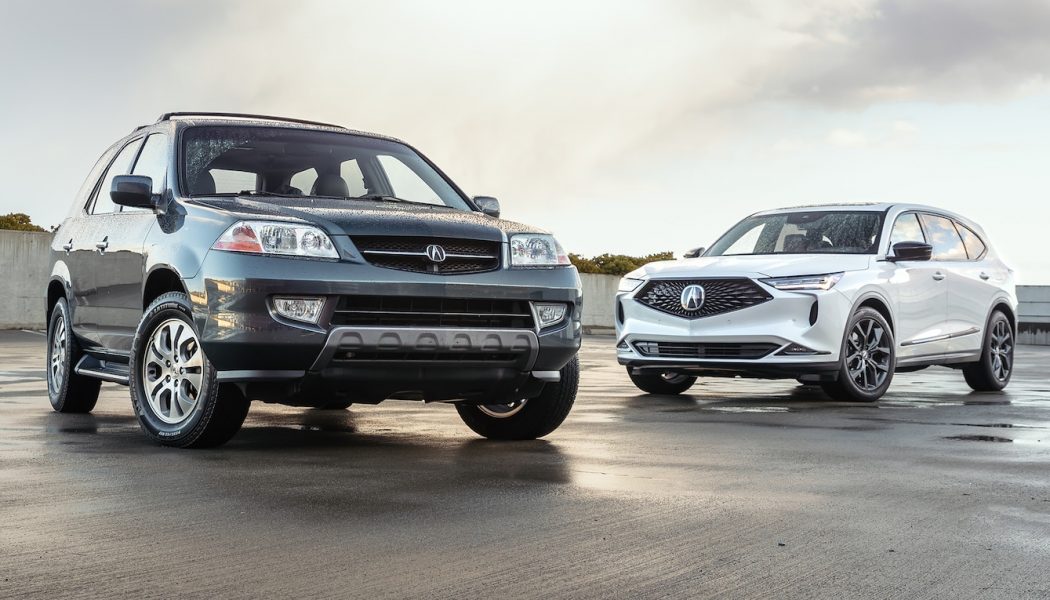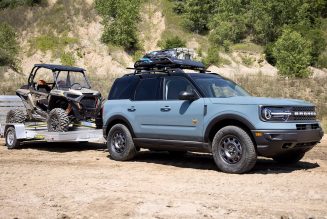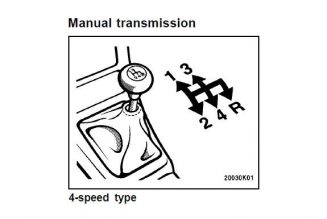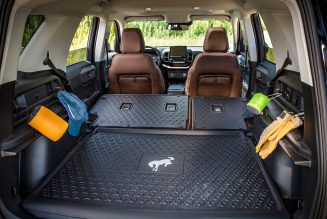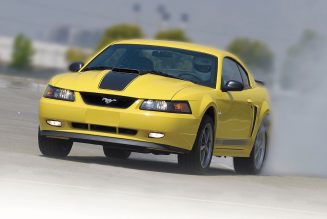I am tugging on the door handle of a classic first-generation Acura MDX, and it is refusing to let me in. This, I will soon realize, is what makes this old MDX such a fantastic SUV.
All of which is irrelevant to my current problem: Why won’t the damn door open? And then I have my forehead-smacking moment: This MDX predates the proximity key, and is completely oblivious to my presence. I can’t unlock it by merely touching the handle, as I can in most new cars; instead I have to tell it I’m here by pushing a button on the key fob. (I suppose I could also put the key in the lock, but what are we, Neanderthals?) The MDX, I realize, is a portal to a not-too-distant past, a time before luxury cars started trying to figure out what we want and just did what we asked.
Despite being on the wrong side of the door, I am starting to like this MDX already.
Finger on fob, the locks clack open and I’m in. Everything in the cabin is so clean and original-looking that it’s hard to believe the 72,500 mile reading on the odometer. The MDX’s interior is a mix of functional plastic, high-zoot leather, and comically-glossy wood trim. The general layout rips off the first-gen Mercedes ML, zig-zaggy transmission shift gate and all, but let’s remember this was Acura’s first home-grown SUV.
I clamber in behind the wheel and take in my surroundings. There’s a touchscreen for the navigation system, a $2,000 novelty at a time when the iPhone was still several years in the future. Oddly enough, the touchscreen also controls the fan speed—the one climate function not handled by a neat pod of buttons between the vents. (Good God, I’ve discovered the missing link between the simple Acuras of yore and the overly complex Acuras of today!) The double-height stereo takes CDs and cassettes but not USB or Bluetooth; holding your cell phone to your face was still legal when this baby was new.
I hop into the back and find climate controls for the rear passengers—how quaint, they’re dials, not buttons. The third-row seats are folded neatly into the floor. I deploy them, attempt to climb back there, and fail spectacularly. The seats are sized for kids, not overweight adults with deteriorating knees. I make it far enough to see that each kid gets a cupholder and an armrest hiding a storage compartment, inside of which I find a small plastic biscuit. A fallen-off trim piece? Nope, it’s a cover for the divot left behind when the window-shade-style cargo-cover is removed. Back In The Day, Acura really did think of everything.
Back in the adult-sized driver’s seat, I take a moment to admire the elegant simplicity of the analog gauges: tachometer, speedometer, fuel, and temp. A hilariously tall list of shifter positions (P, R, N, D5, D4, D3, 2, 1) runs down the side of the tach, a reminder that the MDX’s automatic has five speeds, not the usual four. I put the key into the ignition (“Be-be-be-beep! Be-be-be-beep!”), give it an old-fashioned twist, and it clacks solidly into the On position. I’m greeted not by a fancy start-up screen and a sci-fi audio jingle, but by more beeping and a sparse sprinkling of idiot lights. I twist further and hear—but, remarkably, do not feel—the engine crank and fire.
I try to shift into D5 and wind up in D3 instead. Gawd, I’d forgotten how difficult these old Acura shifters made it to find the gear you actually want. Accelerator tip-in is gentle and the MDX takes off smoothly, but when I feed in a little more throttle, she goes. The transmission holds the gears a little longer than we’re used to nowadays, and the MDX’s 3.5-liter engine reminds me how good a V-6 can sound.
This engine was, and still is, a wonder. When the Acura MDX made its debut for 2001, it delivered 240 horsepower and 250 lb-ft. That was enough to hustle the just-under-4,400-lb MDX to 60 in 8.1 seconds, quicker than all of its luxury-branded rivals and still a respectable time today. The 2003 MDX I’m driving adds an additional 20 horses, and I love the way it delivers power. It’s not champing at the bit trying to barge its way through traffic, but all the acceleration I could ever need is just a foot-prod away.
The MDX’s ride is busy and alive, intended, no doubt, to give a more car-like feel than the truck-based SUVs that were still commonplace at the time. It’s not uncomfortable, but there’s more jiggling and joggling than in a modern-day 2022 Acura MDX. There are no creaks or rattles, only the key fob bouncing against the plastic housing of the steering column with an annoying clop, clop, clop.
I ease the MDX onto the freeway, starting up the on-ramp at a gentle trot then matting the accelerator to get a lower gear—but there is no lower gear to be had. With only five speeds to choose from, third is my only option. The engine builds power and hustles up to freeway speed. I push the dash button to turn on cruise control—not adaptive cruise control, just cruise control—then hit Set. I look at the dash and see… nothing new. No fancy graphic display showing the traffic around me, no indicator of what speed I’ve selected, just a light on the switch and another on the dash. How refreshingly simple! The MDX tracks straight and true, but wind and road noise eclipse the engine’s musical hum. That’s not old age; that was turn-of-the-century Honda/Acura.
I take the next off-ramp and steer towards the curvy roads in the hills, the same route I took the previous day in a contemporary 2022 MDX. The new version impressed me with the way it hustled through the curves, but the first-gen car isn’t quite so athletic. Fancy VTM-4 all-wheel drive notwithstanding, the old MDX gives up its grip at far lower speeds. The steering is a curiosity. It feels heavy and almost unassisted at low speeds, goes light as you start moving, and loads up pleasantly as you turn in—but as soon as you dial in 90 degrees or so of lock, the feedback disappears and the steering wheel bounces around as if it were on a spring.
But really, should I expect more from this first-generation MDX? Back when it was new, Acura had the Integra to satisfy the hot-shoes, and this was supposed to be the big family hauler. Compared to its Y2K contemporaries, the MDX was a revelation—controlled and dignified, whereas the Lincoln Aviators and GMC Envoys of the time were heavy and clumsy. More remarkable than that is this: If a brand-new 2021 crossover drove like this 2003 MDX does, we’d have little to complain about.
Time to try out some of the tech. The MDX has rudimentary voice recognition, but I only get so far as telling it I want to navigate to an address before it refers me to the touch-screen keyboard—which, Heaven save us, lets me type in my destination while the car is moving! I plug in an address—no point trying a business name, as the map DVD dates from 2007—and a female voice, more pleasant-sounding than her daughter in the current-day MDX, advises me to turn left and right. The system is still too primitive to pronounce street names.
I load 10,000 Maniacs’ MTV Unplugged CD into the six-disc changer and am enveloped by music and nostalgia—I had forgotten how crisp and clear music sounds without compression artifacts. Natalie Merchant’s voice is as vivid as the colors she describes in Stockton Gala Days: “Blue in the stream like none I have seen, outside of dreams that escape me.” Why did we ever give up on the compact disc? Lexus, for all those times I made fun of you for still putting CD players in your cars, consider this my public apology.
But I must continue my journalistic investigation, so I pop in a cassette, an Ani DiFranco concert that I attended in June of 1993, then taped off college station WITR-FM the next night. I remember cassettes sounding like crap, but either my memories were wrong or the MDX’s Bose stereo is working some serious magic—or perhaps a bit of both. The sound quality isn’t as good as CD, but it’s a lot closer than I imagine.
I kill the stereo and wander aimlessly about the suburbs, enjoying the way the V-6 goes from purr to snarl and the solid-feeling clunk as you engage the turn signals. Driving a museum-piece classic is often a stress-prone affair, but here in the 2003 MDX, I find myself feeling relaxed and content. What is it about this car that feels so welcoming?
And then the epiphany hits me like a speeding NSX: I am enjoying the 2003 MDX because it is letting me be. It isn’t overwhelming me with tangential trivia on a computer-screen dash or blinding me with 65,536 colors of ambient lighting. It isn’t trying to steer me back into a lane I don’t want or warn me of impending doom in the form of a Prius that’s stopped a quarter-mile ahead.
That is what has changed about luxury cars. They have gone from serving our needs to interpreting and anticipating them—a noble goal, perhaps, but often an invasive one. The first-generation Acura MDX is luxurious, but it’s also simple and fundamental in its human-machine interface. It doesn’t claim to know all and see all. It’s not trying to help me drive. The MDX trusts me and I, in turn, trust the MDX.
My first impression was right: The original Acura MDX is a wonderful car. Even if it wouldn’t let me in.
| 2003 Acura MDX Touring Specifications | |
| PRICE | $40,500 |
| ENGINE | 3.5L valve-train type SOHC 24-valve V-6; 260 hp @ 5,750 rpm, 250 lb-ft @ 3,500-5,000 rpm |
| TRANSMISSION | 5-speed automatic |
| LAYOUT | 4-door, 7-passenger, front-engine, AWD SUV |
| EPA MILEAGE | 17/23 mpg (city/highway) |
| L x W x H | 189.0 x 77.0 x 71.0 in |
| WHEELBASE | 106.3 in |
| WEIGHT | 4,354 lb |
| 0-60 MPH | 8.1 sec |
